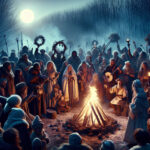The pagan Celtic religion is an ancient belief system that has been around for centuries and continues to be practiced today. It is a polytheistic religion which recognizes multiple deities and has strong ties to nature and the cycle of the seasons. In this article, we will look at the history of pagan Celtic religion, its spiritual practices and beliefs, and what it looks like today. We will explore how this ancient belief system is still practiced and has adapted to the modern world.
Pagan Celtic is a way of life and a spiritual belief system that evolved from the ancient pre-Christian religion of the Celts. It is a polytheistic religion, meaning that its adherents believe in multiple gods and goddesses. Pagan Celtic beliefs and traditions have been handed down from generation to generation, and the beliefs and practices of the ancient Celts are still alive today.
What is the Difference Between Paganism and Celtic Spirituality?
Paganism is an umbrella term used to describe a variety of different polytheistic and animistic spiritual practices. Paganism is typically associated with the pre-Christian beliefs of Europe. Celtic spirituality is an umbrella term used to describe the spiritual practices and beliefs of the ancient Celts. While the two terms are often used interchangeably, they are not necessarily the same. Celtic spirituality is a subset of paganism, focusing on the beliefs and practices of the ancient Celts.
What Are the Core Beliefs of Pagan Celtic Spirituality?
The core beliefs of Pagan Celtic spirituality are rooted in the ancient pre-Christian beliefs of the Celts. The Celts believed in a pantheon of gods and goddesses, who they believed were responsible for the creation and maintenance of the universe. They also believed in a cycle of death and rebirth, and the importance of honoring the natural rhythms of the earth.
Pagan Celtic spirituality also emphasizes the concept of “magick” or “the Craft.” This refers to the use of rituals and spells to bring about desired outcomes. It is believed that the gods and goddesses can be invoked and honored through the use of these rituals.
What Are Some Common Practices in Pagan Celtic Spirituality?
There are many common practices associated with Pagan Celtic spirituality. These include:
Divination: Divination is the practice of using tarot cards, runes, and other tools to gain insight and foresight into the future.
Herbalism: Herbalism is the practice of using herbs and plants to create healing potions and remedies. Herbs are also used in rituals and spells.
Rituals and Spells: Rituals and spells are used to invoke the gods and goddesses, ask for favors and blessings, and bring about desired outcomes.
Sacred Objects: Sacred objects such as crystals and tools are used in rituals and spells.
Celebrations and Feasts: Celebrations and feasts are held to honor the gods and goddesses, as well as to mark important events in the pagan calendar.
What Are Some Common Symbols in Pagan Celtic Spirituality?
Common symbols used in Pagan Celtic spirituality include the triskelion, which is a symbol of the triple goddess, and the triquetra, which is a symbol of the threefold law. Other symbols include the spiral, which is a symbol of the cycle of life, the cauldron, which is a symbol of the goddess, and the pentacle, which is a symbol of protection.
What Are Some Pagan Celtic Festivals?
The most well-known Pagan Celtic festival is Samhain, which is celebrated on October 31st. This festival marks the end of the harvest season and the beginning of the dark half of the year. Other Pagan Celtic festivals include Imbolc, Beltane, and Lughnasadh. These festivals mark the changing of the seasons and the celebration of the gods and goddesses.
What Is the Difference Between Wicca and Pagan Celtic Spirituality?
Wicca is a modern form of witchcraft that was established in the 1950s by Gerald Gardner. It is based on ancient European pagan beliefs and practices, and it is a nature-based spiritual path focused on the divine feminine. Pagan Celtic spirituality, on the other hand, is an umbrella term used to describe the spiritual practices and beliefs of the ancient Celts. While the two share similar roots, they are not necessarily the same.
In conclusion, the Pagan Celtic culture has a long and rich history, and it is still alive and well today. Its beliefs, rituals, and practices have been passed down through the generations and continue to be practiced in many parts of the world. It is a unique and powerful spiritual tradition that has been a part of the human experience for thousands of years. Its influence on modern culture is undeniable, and its ability to provide spiritual guidance and comfort is invaluable. It is an important part of our collective human experience, and its importance should not be overlooked. Pagan Celtic culture is a powerful and meaningful spiritual tradition that is still alive and relevant today.





